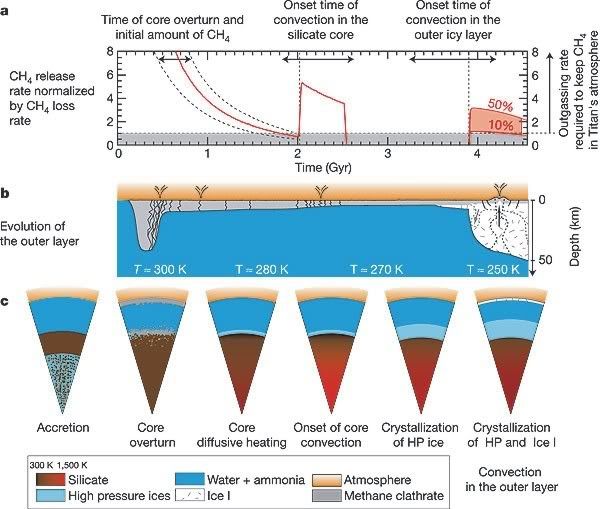Amidst all the excitement as Cassini-Huygens successfully penetrates the smoggy atmosphere of Titan, there is a faint twinge of disappointment – and a mystery. Titan’s atmosphere consists of around 5% methane, which is not stable over geological timescales because it is constantly broken down by sunlight. Before Cassini, scientists proposed that methane in the atmosphere was constantly being topped up by evaporation from extensive lakes and seas of hydrocarbons. Sadly, Cassini revealed that the surface is presently free of such features, although flowing liquid hydrocarbons have almost certainly played a role in shaping the landscape in the past. So where is the methane coming from?
The most likely explanation is that the methane is released from inside Titan by geological activity. Titan has a crust that consists mainly of water ice, and the low surface temperatures mean that some of this ice might be in the form of clathrates (also known as gas hydrates), which trap gases like methane. Heat from Titan’s interior, produced either by radioactivity in a silicate core or tidal heating induced by the gravitational pull of Saturn, could possibly destabilise these clathrates, releasing methane into the atmosphere.
Although Cassini has spotted at least one example of what looks like a cryovolcano, we still know very little about the forces which are driving this activity on Titan, the rates at which it might be occurring, and most importantly whether it is sufficient to explain all of the surface features we are seeing. A paper by Tobie et al.[1] in the March 2 issue of Nature attempts to shed some light on these questions, by presenting a new model of Titan’s interior, and how it has evolved since it formed. This model is nicely summarised in their Figure 2: a plots the rate of methane outgassing over time predicted by the model; b and c show the changing internal structure of the upper 50 km and the whole moon, respectively.
The model proposes that beneath the icy crust is a ‘mantle’ of ammonia-rich water, similar to the one inferred beneath the surface of Europa. In order to stop all of the methane escaping Titan by outgassing during accretion, the authors suggest that the initial proto-core consisted of a mixture of rock and ice, including clathrates, beneath a silicate shell. Because ice is less dense than silicate, this arrangement is unstable – convective overturn would eventually move the silicate to the inner core, and the ice and clathrates would migrate outwards. The low density of the clathrates would allow them to move to the top of the water layer and accumulate at the base of the crust; this thickening inhibited surface heat flow, causing the subsurface ocean to warm to the point where the clathrates started to dissociate and release methane into the atmosphere.
This is the first of three predicted episodes of atmospheric methane release during the last 4.5 billion years, and lasted from ~4 to 2.5 billion years ago. The second episode occurred 2.5 to 2 billion years ago, when the silicate core was heated enough by radioactive decay to start convecting, increasing the heat flow to the surface and triggering further clathrate dissociation.
The methane we presently observe in the atmosphere is due to the third (and final) outgassing episode. As Titan has gradually cooled since 2 billion years ago, the subsurface ocean has begun to freeze, causing a thickening layer of ice to build up beneath the clathrates and outer icy crust. In the last half a billion years this layer has become so thick that convection is now a more efficient method of heat transfer than conduction, leading to upwelling ‘hot’ (relatively!) thermal plumes which drive localised dissociation and venting of methane at cryovolcanos.
This model explains many of the recent observations of Titan, but will stand and fall on the basis of two predictions. The first is the existence of a subsurface ocean; Cassini is conveniently about to start a series of flybys designed to probe the interior of Titan using the Radio Science Subsystem, so we should know the answer to that one fairly soon. The second regards the age of surface features; the model suggests that the current episode of methane release is much more limited in scale than the first two, meaning that most of the large-scale erosional features being observed should date to the last major outgassing 2 billion years ago. If the model is correct, this was also the last time that hydrocarbon seas existed on the surface of Titan. Huygens, it seems, arrived a little too late to surf some oily waves.
[1] Nature 440, p61-64 (doi)
15 March, 2006
A brief history of Titan
Posted by
Chris R
at
10:45 pm
![]()
Labels: geology, planetary geology
Subscribe to:
Post Comments (Atom)




No comments:
Post a Comment